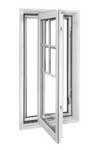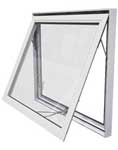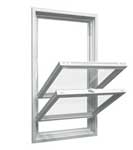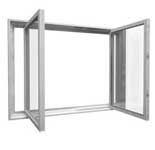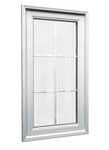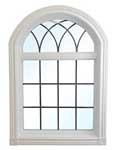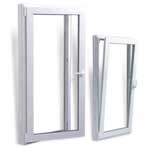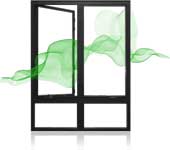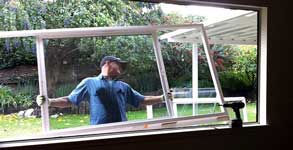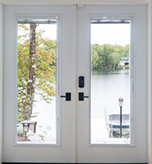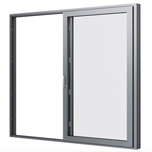Canadian winters can be beautiful, seeing the landscape covered in a soft, glistening layer of snow, the crisp, fresh air, and activities such as ice skating, building snowmen or just having a good old-fashioned snowball fight. If you have lived through a Canadian winter, then chances are high that you have also experienced ice buildup on your windows.
It is a very common problem that has plagued Canadians since windows were invented, so it seems to be an unavoidable phenomenon. At one point, it surely was, but not only has window technology taken a massive step forward throughout the years, but there are some simple methods that can help you reduce or even completely eliminate ice forming on the inside of your windows.
How does Ice Build up on your Windows?
There are many different reasons for ice to form on the inside of a window, even though they all lead to the same result, and the process is the same: Water vapour turns into ice crystals. Every room has a certain level of humidity, and during winter, this level can be even higher than usual as the moisture is trapped inside the room and is drawn to the window pane. As the vapour gets in contact with the cold glass, it condensates and freezes, especially during the night when the temperatures outside drop.
Now, this can also lead to wider-reaching problems because the ice might melt during the day with the water gathering at the bottom of your window, where it can then refreeze. This can lead to further damage to the window and frame itself, but if the water reaches the walls, it can damage paint and wallpaper and even lead to mould and mildew, which can pose serious health risks as well.
There are many different causes for increased moisture in the air, especially during wintertime. Cooking and baking generate steam, just like showers and baths do, and if the ventilation in the kitchen or bathroom is not working properly, it leads to increased moisture buildup, which then can crystallize into ice on the windows. The same also goes for a poorly ventilated laundry room or an improperly installed dryer hose.
Also Read: Winter Window Replacement Tips
Another cause can be a wrong setting on the humidifier of a furnace. During winter, cold air generally is already drier, which is made even worse by heat drying out the air even more. So many Canadians have humidifier units installed on their furnace to increase the humidity of the air and make their homes more comfortable. If the humidifier is not set properly, however, it can release too much moisture and, in turn, cause condensation and ice buildup on your windows.
A crack in a window frame, an aged, broken thermal seal or an improperly installed window also can be sources for both moisture and cold air creeping into your home. This can not just increase the moisture in the air but also lead to leaks into the wall and cause even bigger issues.
So, as you can see, while the end result is the same, there are many different factors that can play in a role in causing window ice.
How to Stop Ice Buildup on your Windows?
Finding out the cause of too much moisture in your home is a great first step to eliminating the problem. Here are a few handy solutions that can help you reduce ice buildup on your windows or even eliminate it completely.
Ensure ventilation
Make sure to turn on your exhaust fans both in the kitchen and the bathroom. This will draw excess moisture from the room to the outside and reduce the potential for ice buildup. Alternatively, on warmer days, you can also open your windows to allow for some air exchange. If you use firewood, also make sure to store it outside as moisture from the wood evaporates in warmer indoor temperatures.
Avoid air-drying your clothes
Refrain from air-drying clothes inside your home because this can add a lot of additional humidity to the room. Try to remove as much moisture as you can by using your clothes dryer if you can’t avoid hanging them up inside. Also, make sure to check the hookup of the dryer vent to ensure that it is sealed properly. This will prevent extra moisture from entering the house.
Use a dehumidifier
While this may seem counterproductive if you use a humidifier on your furnace, it is an efficient way to remove excess moisture from a room. Also, make sure to check the settings of your furnace humidifier, if you use one, to ensure it is not set too high.

Keep your home warm
One reason for ice buildup is dropping temperatures during the night. By increasing the temperature on your thermostat, you can help keep the air warm enough to reduce the chance of moisture freezing on the window pane. If there is one particular room that is problematic in terms of ice buildup, consider using a space heater.
Check your windows
Check your windows for potential leaks with cold air and moisture entering your home. A weakened thermal seal can cause leakage, and while caulking might only be a temporary solution, it can bring relief during the cold months. You can also buy a window insulation kit consisting of plastic shrink film and double-sided tape to increase insulation and reduce condensation. You can find these kits at most hardware stores.
Fix leaky faucets
Malfunctioning faucets can also add moisture to the air through the constant dripping of water.
Absorb excess moisture with a towel
Absorb excess water with a rolled-up towel on the window sill during the night. This will collect water that pools at the bottom of the window and stop it from freezing on the glass. Ensure to replace the towel with a dry one once a day or whenever it is getting too wet to absorb.
Consider installing new windows
Replacing single-pane windows with double- or triple-pane units can dramatically increase the insulation of your home during winter and also save you money by reducing your energy bills. If you decide to update your windows, make sure to choose high-performance Energy Star-certified models to get the most energy-efficient windows. They also can offer additional insulation against energy loss and leaks through technologies such as argon or krypton gas and special coatings.
So, while winter brings its own challenges to homeowners and tenants, ice buildup on your windows does not have to be one. By preparing yourself for the cold season and following these simple methods, you can either strongly reduce or even completely eliminate the problem of ice on the inside of your windows.
Speak to one of Eco Choice Windows & Doors’ experienced specialists for more information on how new, energy-efficient windows can help you increase the comfort of your home with a free, no-obligation consultation.

